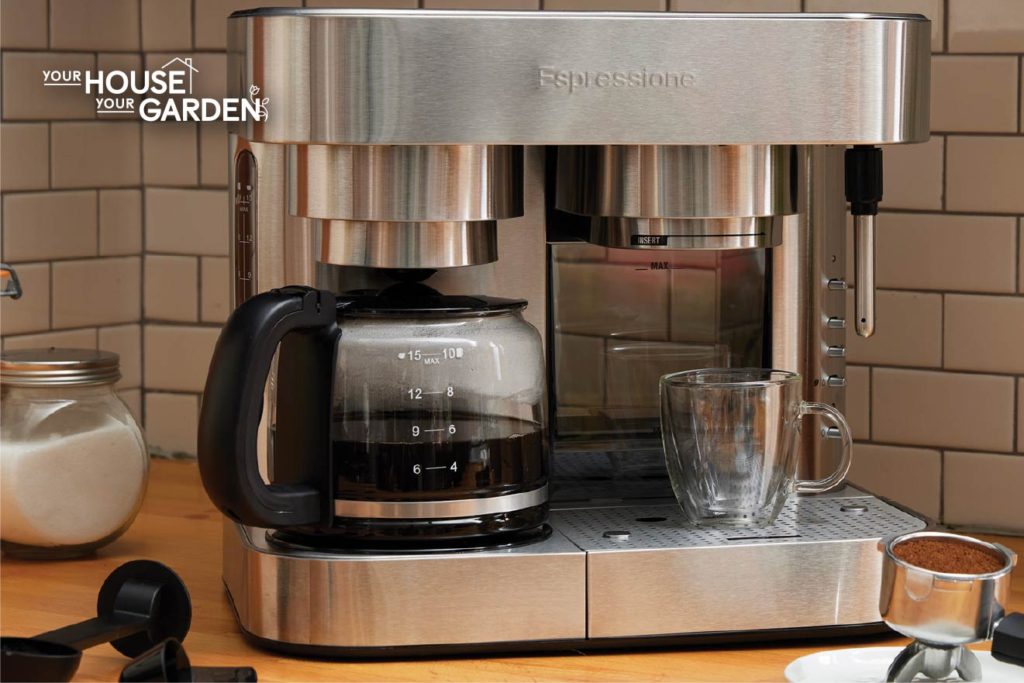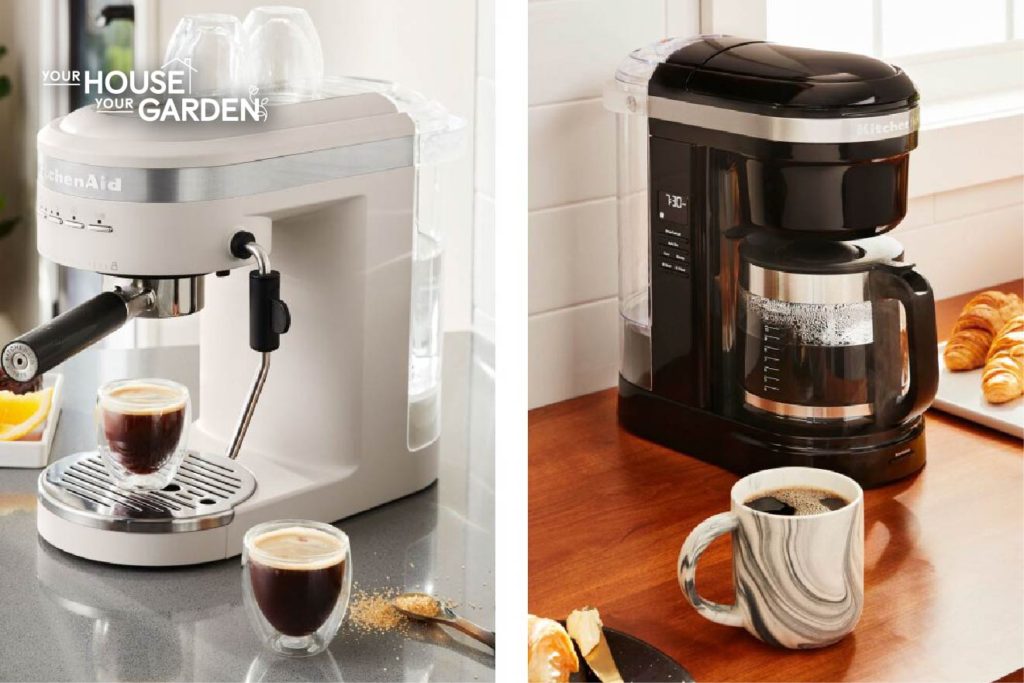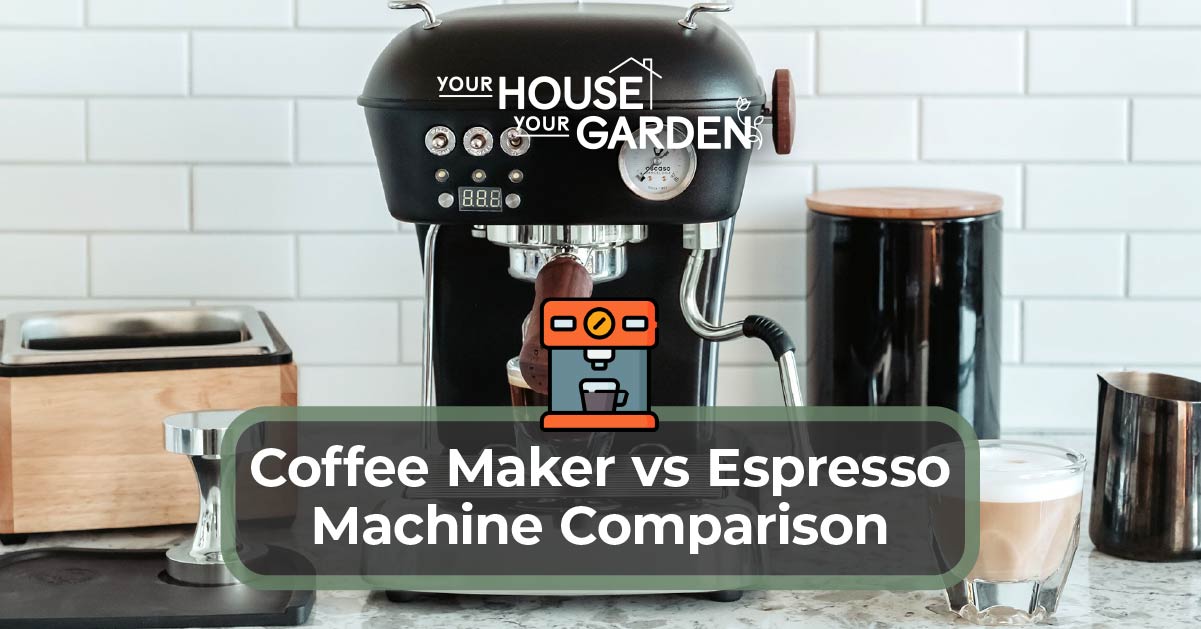A drip coffee maker allows you to brew your favorite coffee in large batches. Also, an espresso machine allows you to brew tasty shots of espresso.
While these appliances help you sip on your daily fix of coffee, they differ in many ways: hence, the need for the coffee maker vs espresso machine debate.
To find out which of these coffee makers will be the best option for you, we’ll explore the coffee maker vs espresso machine in-depth.
Let’s find out the differences between a coffee maker and an espresso machine.
Differences between A Coffee Maker vs An Espresso Machine
The major difference between a coffee maker and an espresso machine is in the type of coffee they make.
Coffee makers make drip coffee which has a grounds to water ratio of 1:18 for servings of 6 – 8 oz. While espresso makers brew espresso which has a grounds to water ratio of 1:2 for brewing 1 – 2 oz. servings.
The second main difference between a coffee machine and an espresso machine is in their brewing method.
Coffee makers brew coffee by allowing hot water to drip gradually from the machine through the coffee grounds into your coffee pot. An espresso machine works by pushing a little amount of hot water under high pressure through the ground coffee.
To better understand how these home appliances can make different types of coffee, we’ll explore them individually.
What is a coffee maker? A coffee maker, also called a coffee machine or drip coffee maker, is a machine for brewing ground coffee using pour-over technique. They are very affordable and are the most common machines used for whipping up homebrewed coffee.
In the brewing method, you’ll add coffee grounds to the filter and pour water into the reservoir. The coffee maker then heats up the water before allowing it to gradually drip into the grounds, and the coffee then collects in your container or coffee pot.
Coarse coffee grounds are used for making filter coffee. And the filtration process takes between 5 and 10 minutes, and you can get multiple cups of coffee in one batch.
Brewing coffee with a coffee maker is an easy process. After loading the coffee grounds and water into the machine, simply push the ‘Start’ button, and it takes care of the rest. Coffee brewed using coffee machines is light and not so flavorful due to the coffee filter soaking up the oils and the high volume of water used in relation to the grounds (18:1).
While filtered coffee may not be the most flavorful coffee, they’re considered healthy by experts because they filter the oils in the grounds that are considered unhealthy.
What is an espresso machine? An espresso machine brews coffee by using high pressure and speed to force a small amount of hot water through coffee grounds to make shots of espresso. These machines have their origins in Italy.
Also, the small amount of water used in the brewing process causes the coffee brewed by an espresso machine to be thick, creamy, and rich in flavor. They also contain a higher amount of caffeine. Another good thing about espressos is that other types of coffee such as lattes, macchiato, and cappuccinos, etc., can be made from them.
To make espresso, fine grounds of coffee beans are needed. The brewing process doesn’t require a filter and typically takes a few seconds to complete. This allows the natural oils to seep into the brew, resulting in a dark and rich drink.
Superiorities of a coffee maker to an espresso machine
The benefits of brewing ground coffee with a coffee maker rather than an espresso machine are that it’s a more affordable coffee maker that’s easy to use in brewing healthy coffee.
Ease of use
When compared to using an espresso machine to brew coffee, a coffee maker is easier to use even for a first timer.
Simply measure your grounds of coffee and add them to the filter, then add water to the reservoir. Push ‘Start’ to begin brewing and the machine will heat the water and filter the coffee grounds to make your coffee. It’s an automated process that you can set and leave. Here are the use cases of a coffee maker.
Using an espresso machine may be a bit difficult as it’s more hands-on: unless you have an automatic espresso machine.
Healthier coffee brew
Filtered coffee has been said to be healthier than espresso due to the thorough filtration process.
Also, a higher volume of water is used to filter the coffee in a ratio of 18:1. This is in contrast to the smaller volume of water used in making espresso – 2:1 (two parts water and 1 part coffee grounds).
In addition, the coffee filter ensures that some dangerous oils don’t seep into your cup. This makes drip coffee lighter and less concentrated than espresso.
And espresso machines don’t use filters: therefore all the oils in the grounds end up in your cup.
Works with most grinders
The kind of coffee grounds required by a drip coffee maker is coarse as opposed to finer grinds with espresso.
Most grinders can yield coarse grounds: for example, coffee grinders that yield fine grounds can be set to yield a coarser grind. This means you can use your coffee grinder, spice grinder, or blender to grind coffee beans for your coffee. Espresso machines, on the other hand, require finer coffee grounds processed by specialty coffee grinders.
More affordable
When compared to an espresso maker, a drip coffee machine is a more affordable option.
Drip coffee makers cost between $20 and $350 while espresso coffee makers cost around $150 and $1000. Espresso machines are so expensive because of the rich quality of espressos they make.
Superiorities of an espresso machine to a coffee maker
The benefits of using an espresso machine to brew coffee over a coffee maker are that it’s a versatile coffee maker that produces coffee that’s richer in flavors in speed time.
Flavorful coffee
When compared to drip coffee makers, espresso coffee machines are designed to brew specialty coffee.
The resulting drink is thick, creamy, and violently rich in flavors and caffeine due to the brewing method that allows the natural oils in the coffee grounds to seep into your cup. Drip coffee makers use pour-over filtration technique that gets rid of lots of the oils in the grounds – the product is a lighter drink that’s less flavorful.
A 225 ml of coffee brewed by a coffee maker can produce between 95 mg and 165 mg of caffeine while an espresso machine can produce between 375mg and 520 mg of caffeine in a 225ml shot.
However, there may be more caffeine in your pour-over coffee than espresso due to the volume of the drink your drip coffee maker brews.
More versatile brewer
First, espresso serves as the primary ingredient for other drinks such as lattes and cappuccinos. Also, some espresso machines can make these drinks. Drip coffee makers, on the other hand, aren’t good for making other beverages other than filtered coffee.
Faster brewing
Espresso machines brew coffee faster than drip coffee makers due to their brewing method and their finer coffee grind requirement. It usually takes around 30 seconds for an espresso coffee maker to brew a batch while it takes a drip coffee maker between 5 and 10 minutes.
Food Differences between A Coffee Maker and An Espresso Machine
Unlike popular belief that you can only make coffee and espresso in your drip coffee maker and espresso machine respectively, these appliances can do a lot more. Let’s find out the other beverages you can make in your coffee maker and espresso maker.
What foods can be made in a coffee maker?
You can make the following foods in your coffee maker;
- Coffee
- Grilled cheese
- Broccoli
- Soup
- Jimmy Dean sausage
- Rice
- Corn
- Ramen
- Hot toddy
- Pancakes
- Oatmeal
- Poach fish
- Hard-boiled eggs
- Chocolate fondue
- Hot dogs
- Scrambled eggs
- Mini cupcakes
Here’s how to use a coffee maker.

What foods can be used in an espresso machine?
You can make the following beverages in your espresso machine
- Espresso
- Mocha
- Espresso Romano
- Cappuccino
- Latte macchiato
- Double
- Café latte
- Espresso macchiato
Using a coffee maker and an espresso machine
You can use a coffee maker and an espresso machine together in a kitchen. Coffee makers are great at making drip coffee which is light and healthy due to the high volume of water and the brewing technique. Espresso machines, on the other hand, are used for making espresso and other coffee-derived beverages.
What are the instances where a coffee maker and an espresso machine can be used together?
If you love starting your day with your coffee fix, you can set your drip coffee maker to make a cup of coffee for you early in the morning. And when you want to enjoy a cup of richly flavored coffee much later in the day, you can brew shots of espresso, cappuccino, or other beverages.
What are the instances where a coffee maker and an espresso machine should never be used together?
You shouldn’t use your coffee maker and espresso machine together if you don’t love drinking both filtered coffee and espresso. Instead, you should get the machine that makes the kind of coffee you prefer.
Coffee Maker vs Espresso Machine Purchasing Tips
If you’re unsure about choosing a coffee maker or an espresso machine, these are the most important factors to consider before making a purchasing decision.
What are the types of coffee makers and espresso machines?
There are three types of drip coffee makers; thermal coffee maker, glass carafe coffee maker, and dual pot coffee maker.
A thermal coffee maker is designed for coffee lovers that drink coffee several times in a day. It can keep coffee warm for a long time due to its insulation.
Glass carafe coffee makers aren’t designed for keeping coffee warm for a long time – only 20 minutes. However, you can view the quantity of your coffee as the appliance is made of glass. Glass carafe coffee machines come with timers for you to set the brewing time. To keep the coffee in glass carafe models warm, you can put them on a hot plate.
A dual pot coffee maker is designed for a setting like an office with lots of coffee lovers. It comes with two brewing stations for brewing more than one flavor of coffee at the same time.
There are different types of espresso machines. However, they can be broken down into three categories; automatic, semi-automatic, and manual espresso machines.
Manual espresso machines are the most affordable espresso machines, but they’re difficult to use. You’re in charge of the whole brewing process from measuring the coffee grounds to adding the water (the brew ratio) and controlling the frother.
Semi-automatic espresso machines are the most common espresso coffee machines as they’re not as difficult to operate as manual models. You’ll have to fill the reservoir with water and push start the appliance to brew your coffee.
Full or super-automatic espresso machines are fully automated. They come with a fully integrated water system so you don’t have to measure the amount of water needed for the brewing process. All you have to do is load the machine with your ground coffee, and they’ll do everything for you.
How much coffee do these coffee makers brew?
Coffee makers brew more cups of coffee than espresso machines.
A 12-cup drip coffee maker will make 12 cups of 6 ounces of servings while an espresso machine will make around 2 or 3 shots (2 or 3 ounces) of espresso.
How much does a coffee maker or espresso machine cost?
Coffee makers are more affordable than espresso machines. A good coffee maker costs around $20 and $120 while an espresso machine will cost around $120 and $500.
Which is more usable?
This depends on personal preference. If you have lots of coffee-loving friends, you may want to go with a drip coffee maker as it can brew more cups of coffee. But if you prefer more flavorful and tastier cups of coffee and have the expertise to make espresso shots, an espresso machine is worth it.

Best Brands for Coffee Makers
The five best brands making the best coffee makers are Breville, Black & Decker, Capresso, Cuisinart, and Ninja.
Breville
Breville makes some of the best coffee makers you can find. The top features that define their models are their compact sizes, cool designs, ease of use, and reliability in making excellent homebrew. They’re affordable and can brew a wide variety of coffee.
Black & Decker
Black & Decker is one of the best brands making the best coffee makers. Their models are budget-friendly without compromising on quality. They’re also easy to use when compared to other coffee makers.
Capresso
Another coffee-making brand that’s easy to use is Capresso. They have a wide variety of models ranging from large to small units that can brew a few cups of coffee. They’re also reliable and come with lots of features to make brewing coffee a smooth process.
Cuisinart
Cuisinart makes some of the best kitchen appliances, and their coffee makers have lots of positive reviews. The brand is known for its excellent and reliable brewing. They are packed with desirable features. Some of their models have no carafe, so you can easily serve yourself from the reservoir.
Ninja
Ninja is one of the best brands making the best kitchen appliances. Their models allow you to make coffee-bar drinks at home. You can make a wide variety of coffee, tea, and cold brew with Ninja coffee makers. However, they’re quite expensive and may not be ideal for casual coffee drinkers.
Best Brands for Espresso Machines
The five best brands making the best espresso machines are Nespresso, Breville, De’Longhi, Gaggia, and Philips.

